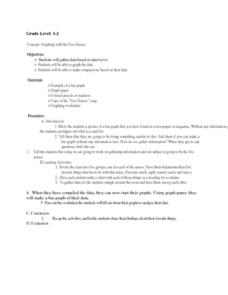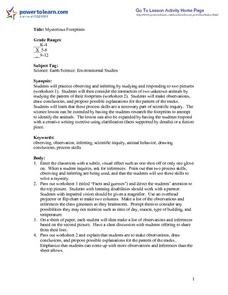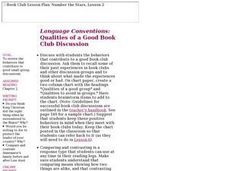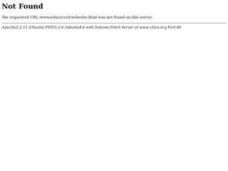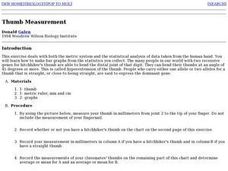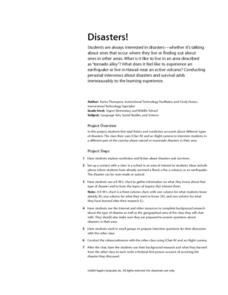Curated OER
4.2: Exploring Rocks
Students collect and look at rocks and write down information about them in science notebooks. They make comparisons and sort the rocks according to their properties, and then discuss their findings with their classmates and put them on...
Curated OER
Project 1
Learners are given a coin to observe and make inferences about. Using a worksheet, they make two columns to list their observations and inferences in an organized manner. They develop a hypothesis based on one of the inferences and...
Curated OER
More Rocket Science
Students observe two rocket science experiments, and create a graph to demonstrate the results. They draw a picture and write an explanation of the results of the experiments.
Curated OER
Graphing with the Five Senses
Students collect data and record it on a bar graph. In this data graphing lesson, each small group of students is assigned to collect data on one of the five senses. They then practice a song that helps them remember the purpose of each...
Curated OER
Sounds Good To Me
Students view and discuss a video about sounds. They complete a worksheet that sorts sounds according to two columns - sounds students might hear in their neighborhoods and sounds they would not.
Curated OER
Mysterious Footprints
Students, after observing and responding to two pictures, consider the interaction of two unknown animals by examining the pattern of their footprints. They make observations, draw conclusions and propose possible explanations for the...
Curated OER
Under the Sea
Young scholars identify and interpret that non-fiction books have features like a table of contents, a glossary, and an index, which can efficiently help them find information. They also identify how to narrow the search for information...
Curated OER
Unit 5 Lesson 01: Graphing on a Number Line
Math masters are introduced to graphing inequalities on a number line. After reviewing inequality symbols, they practice representing them on a worksheet. This simple lesson serves its purpose.
Curated OER
Three R's to Environmental Stewardship: Earth Day
Students explore the ways to conserve our natural resources. In this recycling, reusing, and reducing lesson students read Dinosaurs to the Rescue and apply their findings to learning ways to conserve resources. Students complete a...
Curated OER
Number the Stars, Lesson 2
Young scholars discuss the qualities of a good book club. They explore the behaviors that contribute to a good book club discussion. Also, they compare/contrast a response type that could be used any time in their reading logs.
Curated OER
Friction and Gravity
Seventh graders identify the factors that determine the strength of the friction forces when two objects push against each other. Describing the difference between weight and mass, they participate in experiments. They state the law of...
Curated OER
What Goes Up Must Come Down!!
Fifth graders look at actual sunrise and sunset times for their hometown to determine a pattern in the amount of daylight. They collect their data in Excel and create a chart to help them identify the pattern, then write an explanation...
US Department of Agriculture
Sink or Float?
Will it sink or will it float? Learners predict the outcome as they drop random objects into a container of water. Then, they keep track of the results and record the data in a t-chart to draw a final conclusion.
Curated OER
Eggs-tra Special Sounds
Students explore different sounds. In this sound lesson, students participate in an egg hunt. The eggs are filled with different materials and hid around the room. Students find the eggs and chart the different sounds they hear. Students...
Curated OER
Intro to Mayan Numbers
Students investigate Mayan Numbers. For this algebra lesson, students compare our number system to the number system of the Mayans. They identify base 10 and base 20 numbers including zero in the Mayan symbols. They solve a Mayan problem.
Curated OER
DASH Sunrise and Sunset/ Seasons Chart
Second graders rotate as the person to enter the information of sunrise and sunset into a spreadsheet. The teacher also demonstrates how to convert the spreadsheet into a chart.
Curated OER
Compost Columns
In this unit of lessons, students examine the role of compost columns and recycling. They create a KWL chart about garbage in Chicago. They also examine life cycles and packaging of everyday products.
Curated OER
Thumb Measurement
Students practice measuring using the metric system and millimeters. They measure their thumbs and record their findings. Students record the findings of their classmates and find the average or mean for the two groups.
Curated OER
Disaters!
Students read a fiction and nonfiction accounts about different types of disasters. The class uses iChat AV and iSight camera to interview students in a different part of the country about natural or manmade disasters in their area....
Curated OER
Meet the Plants
Students examine the difference between living and non-living things. In this living versus non-living lesson plan, students complete a KWL worksheet and a Living and Non-Living Chart. They examine a variety of plants and non-plants...
Curated OER
Living and Nonliving Things
Students photograph five objects from a bag and five objects from the outdoors. Students categorize things by living and non-living and by properties such as color, size, structure and needs. Students draw conclusions about the basic...
Curated OER
Making Tracks
Fifth graders examine the fossil footprints of two and four legged dinosaurs. Using this information, they try to determine how the dinosaurs lived their lives. They use their own walking pattern to compare it to the dinosaurs and...
Curated OER
Seeds! What is Inside; How does it Grow and Why is it Important?
Students discover the importance of seeds in relationship to nature. In this plant growth lesson plan, students create a collection of seeds and discover the best type of environment to plant them. Students plant their own...
Curated OER
Outdoor Activities/Problem Solving: Math Goes to the Playground
Young scholars build their math skills outdoors. In this early childhood math lesson, students use comparative language as they chart and graph the items on their playground.
